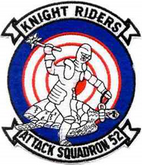VA-52 Knightriders A-6A Intruder

A-6A Aircraft Avionics Systems
 The Grumman A-6 Intruder was an American, twin jet-engine, mid-wing all-weather attack aircraft built by Grumman Aerospace. The initial version of the Intruder was built around the complex and advanced DIANE (Digital Integrated Attack/Navigation Equipment), intended to provide a high degree of bombing accuracy even at night and in poor weather. DIANE consisted of multiple radar systems: the Norden Systems AN/APQ-92 search radar replacing the AN/APQ-88 on YA-6A, and a separate AN/APG-46 for tracking, AN/APN-141 radar altimeter, and AN/APN-122 Doppler navigational radar to provide position updates to the Litton AN/ASN-31 inertial navigation system. An air-data computer and the AN/ASQ-61 ballistics computer integrated the radar information for the bombardier/navigator (BN) in the right-hand seat. TACAN and ADF were also provided for navigational use. When it worked, DIANE was perhaps the most capable nav/attack system of its era, giving the Intruder the ability to fly and fight in even very poor conditions (particularly important over Vietnam and Thailand during the Vietnam War). It suffered numerous teething problems, and it was several years before its reliability was established.
The Grumman A-6 Intruder was an American, twin jet-engine, mid-wing all-weather attack aircraft built by Grumman Aerospace. The initial version of the Intruder was built around the complex and advanced DIANE (Digital Integrated Attack/Navigation Equipment), intended to provide a high degree of bombing accuracy even at night and in poor weather. DIANE consisted of multiple radar systems: the Norden Systems AN/APQ-92 search radar replacing the AN/APQ-88 on YA-6A, and a separate AN/APG-46 for tracking, AN/APN-141 radar altimeter, and AN/APN-122 Doppler navigational radar to provide position updates to the Litton AN/ASN-31 inertial navigation system. An air-data computer and the AN/ASQ-61 ballistics computer integrated the radar information for the bombardier/navigator (BN) in the right-hand seat. TACAN and ADF were also provided for navigational use. When it worked, DIANE was perhaps the most capable nav/attack system of its era, giving the Intruder the ability to fly and fight in even very poor conditions (particularly important over Vietnam and Thailand during the Vietnam War). It suffered numerous teething problems, and it was several years before its reliability was established.
A-6 Intruders first saw action during the Vietnam War, where the craft were used extensively against targets in Vietnam. The aircraft's long range and heavy payload (18,000 pounds or 8,200 kilograms) coupled with its ability to fly in all-weather made it invaluable during the war.
Capt. Rick Hauck, USN (Ret.) — A-6 Aviator, Astronaut
"Years later, after I had flown the space shuttle, I was often asked whether piloting a spacecraft was the most difficult thing I had ever done. I invariably replied: No, I used to land A-6s on aircraft carriers at night!"
VA-52 Intruders on Inaugural Vietnam Combat Cruise
On September 7, 1968 the VA-52 Knightriders squadron made its first Vietnam combat deployment with the A6-A Intruder aboard the USS CORAL SEA (CVA-43) with CVW-15. This first deployment lasted until the ship was relieved from WESPAC and the squadron returned to NAS Whidbey Island, WA on April 18, 1968. This was the first Intruder deployment aboard a Midway Class carrier.
October 13, 1968: CDR Quinlen R. Orell with his Bombardier/Navigator, LT James D. Hunt, launched on an armed reconnaissaince mission over North Vietnam. During their egress from the target area the aircraft passed through an area of reported anti-aircraft fire. Orell's aircraft was successfully tracked by U.S. surface ship radar as having crossed the coast and back out to sea. Immediately thereafter, radar and IFF contact was lost and no further radio transmissions were received. Search and rescue efforts were unsuccessful. The last known location of the plane was near the coast of North Vietnam about 25-miles southwest of the city of Vinh and about 10-miles north of the city of Ha Tinh. The plane is listed as an over/water loss. Hunt and Orell were classified Missing in Action, 
 a status which was maintained for the next ten years. Finally, in 1978, both were declared Presumed Killed in Action,
a status which was maintained for the next ten years. Finally, in 1978, both were declared Presumed Killed in Action, 
 based on no proof that they were any longer alive.
based on no proof that they were any longer alive.
Copyright © 2019 Bert McNamee, Harleigh, PA. All rights reserved.




